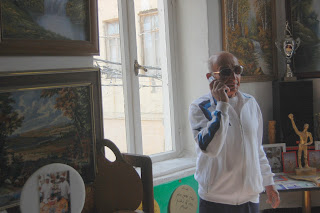Armenia 1

'Please do not bargain' reads the sign on the babushka stand in Yerevan's market.
The opportunity to spend a few days in Armenia, mainly in Yerevan the capital, gave me with a taste of life in the southern Caucasus, a part of the world not often heard about until trouble breaks out there and one not often on our minds here in our own turbulent Middle East. But after learning something about the complex Ngorno Karabakh conflict (too complex to go into here) I couldn't avoid noting some comparisons.

Kids in the Tigranashen village, Armenia, once populated by Azeri citizens of Armenia and now by Armenian refugees from Azerbaijan. The population swap was carried out in the last days of USSR.

In case you were wondering, "Armenia is a landlocked mountainous country in South Caucasus between the Black Sea and the Caspian Sea. Located at the juncture of Eastern Europe and Western Asia, it borders Turkey to the west, Georgia to the north, Azerbaijan to the east, and Iran and the Nakhchivan exclave of Azerbaijan to the south." (Wikipedia).
Of these surrounding countries, the borders with Turkey and Azerbaijan are closed, just as Israel's borders are closed to its north. Like Israel too, Armenia has had its own Armenian genocide, its diaspora, and its occupied territories. So, all in all, I felt quite at home.

Armenian soldiers on the streets of the capital Yerevan
The history of the Ngorno Karabakh conflict is long and convoluted. Suffice it to say that today, Ngorno Karabakh is a self declared Republic now populated only by Armenians that is de jure part of Azerbaijan. The Armenian army also controls another 9% of Azerbaijani territory in buffer zones around Karabakh. The oil rich Azerbaijanis are however buying up arms and threatening to retake the region by force. Meanwhile, the Minsk Group (Russia, US, France) is supposed to be working out a diplomatic solution. Russia supports the Armenians. Turkey supports Azerbaijan. The Armenians want the Turks to recognise the Armenian genocide while the Turks have been softening their line on relations with Armenia somewhat. The Armenians, nearly all of them Christians, are also keen to maintain friendly relations with their neighbours the Iranians. Got all that?

A cinema in central Yerevan. The Armenian language reigns but until 1991, this was the capital of a Soviet Republic so people also speak Russian. The town , we were told, was also full of Iranian tourists, celebrating the Iranian new year.

Rosanna was born in Ngnorno Karabackh, fled the war, and moved to three different countries before returning to Yerevan. Her aristocratic family is trying to regain the land it lost to the Soviets. Like all Armenians she would like the Turks to recognise the 1915 genocide and for Mount Ararat at which she's gazing in this photo, to again be part of Armenia.

A cinema in central Yerevan. The Armenian language reigns but until 1991, this was the capital of a Soviet Republic so people also speak Russian. The town , we were told, was also full of Iranian tourists, celebrating the Iranian new year.

Rosanna was born in Ngnorno Karabackh, fled the war, and moved to three different countries before returning to Yerevan. Her aristocratic family is trying to regain the land it lost to the Soviets. Like all Armenians she would like the Turks to recognise the 1915 genocide and for Mount Ararat at which she's gazing in this photo, to again be part of Armenia.
 This Armenian couple in the isolated village of Eghegnavan are refugees from Baku in Azerbaijan. There, he was an oil drilling engineer, while here they live in poverty. They show us the deeds to their house in Baku where, they said, their neighbours turned on them overnight. Some 32,000 Armenians were exchanged for over 600,000 Azeris in the "ethnic cleansing" during the Ngorno Karabakh war.
This Armenian couple in the isolated village of Eghegnavan are refugees from Baku in Azerbaijan. There, he was an oil drilling engineer, while here they live in poverty. They show us the deeds to their house in Baku where, they said, their neighbours turned on them overnight. Some 32,000 Armenians were exchanged for over 600,000 Azeris in the "ethnic cleansing" during the Ngorno Karabakh war.
Like the Promised Land, Mount Ararat, actually situated in Turkey, can be seen but not reached.
More photos of Armenia here



Comments